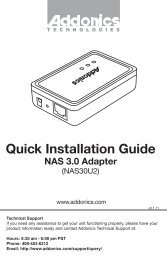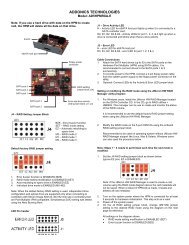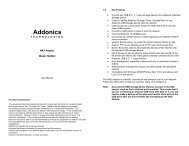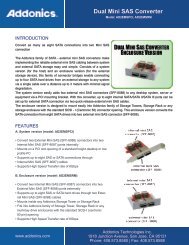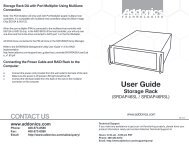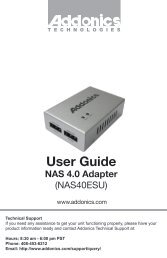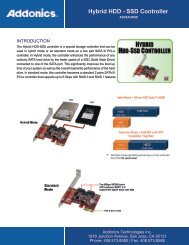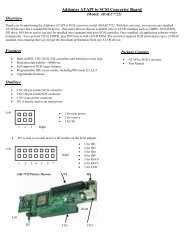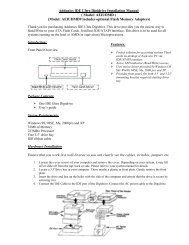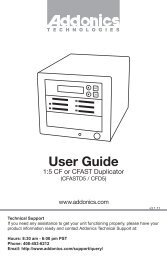User Guide RAID Rack - Addonics
User Guide RAID Rack - Addonics
User Guide RAID Rack - Addonics
You also want an ePaper? Increase the reach of your titles
YUMPU automatically turns print PDFs into web optimized ePapers that Google loves.
T E C H N O L O G I E S<br />
<strong>User</strong> <strong>Guide</strong><br />
<strong>RAID</strong> <strong>Rack</strong><br />
(RR2035RSDMS)<br />
www.addonics.com<br />
v8.1.11<br />
Technical Support<br />
If you need any assistance to get your unit functioning properly, please have your<br />
product information ready and contact <strong>Addonics</strong> Technical Support at:<br />
Hours: 8:30 am - 6:00 pm PST<br />
Phone: 408-453-6212<br />
Email: http://www.addonics.com/support/query/
Array 1<br />
Array 2 Array 3<br />
Front<br />
Power Switch<br />
System Reset<br />
Back<br />
Array 4<br />
Fans<br />
Buzzer Reset<br />
LED Display<br />
Redundant Power Supply<br />
Mini SAS Connector<br />
Power Switch: This is the switch to power on devices connected to the power<br />
supply. The power LED will light up to indicate power is supplied.<br />
Note: The main power switch located at the back of the enclosure must be turned<br />
on first.<br />
Reset Button: Not operational.<br />
Buzzer Reset: Pressing the button stops the overheat buzzer from making a sound.<br />
The buzzer will make a sound when temperature inside the storage rack exceeds the<br />
temperature setting on the Thermal Management card.<br />
Note: Buzzer reset switch does not silence the port multiplier buzzer.<br />
Power LED: Lights up when the power switch is turned on.<br />
Temp LED: Lights up when temperature setting inside the storage rack exceeds<br />
the setting on the thermal card.<br />
Fan LED: Normally on when fan is operational. If an abnormal condition is<br />
detected, the LED flashes.<br />
HDD LED: Not operational.<br />
www.addonics.com Technical Support (M-F 8:30am - 6:00pm PST) Phone: 408-453-6212 Email: www.addonics.com/support/query/
<strong>RAID</strong> <strong>Rack</strong> with Port Multiplier Compatibility<br />
Note: When configured as a set of individual drives, the Port Multiplier<br />
will only work with a Port Multiplier aware host. Identify your host controller<br />
and check with its hardware manufacturer if you are unsure. <strong>Addonics</strong><br />
offers several Port Multiplier capable host adapters.<br />
Power Supply and Host Connection<br />
The redundant power supply provides 500W of power. Before turning on<br />
the main switch located on the front panel of the <strong>RAID</strong> <strong>Rack</strong>, connect and<br />
switch on both units in this power supply. If only one power supply is<br />
running, an audible alarm will sound.<br />
Connect the unit to a computer using the provided mini SAS cable before<br />
powering up the <strong>RAID</strong> <strong>Rack</strong>.<br />
www.addonics.com Technical Support (M-F 8:30am - 6:00pm PST) Phone: 408-453-6212 Email: www.addonics.com/support/query/
Installing drives into the <strong>RAID</strong> <strong>Rack</strong><br />
1. Be sure the lock on each drive door is in an unlock position. If not, use the key<br />
that comes with the Disk Array to unlock the drive door. Pull on the door lever to<br />
swing open the drive door all the way.<br />
2. Slide a 3.5” SATA hard drive into the drive slot with the drive connector side<br />
facing in. Be sure to orient the hard drive correctly as shown in the yellow label<br />
on the inside of the drive door – with drive door swing open at the bottom, the<br />
top of the hard drive should face to the right. The drive should slide all the way<br />
into the slot with very little resistance. Forcing the drive into the slot will cause<br />
drive damage or permanent damage to the Disk Array.<br />
3. Once the drive is all the way into the drive slot, close the door all the way till the<br />
drive door latch securely. This will engage power and data connection with the<br />
hard drive. The LED lit for the drive slot should lit if the Disk Array already<br />
powered on. You may lock the drive door with the key.<br />
4. To remove the hard drive from the Disk Array, simply follow the step 2 – 3 in<br />
reverse.<br />
Insert hard drives<br />
with top facing right<br />
Door lock<br />
Individual drive<br />
bay door<br />
Main Power LED<br />
for each array<br />
Power & Activity LED for<br />
each drive bay<br />
www.addonics.com Technical Support (M-F 8:30am - 6:00pm PST) Phone: 408-453-6212 Email: www.addonics.com/support/query/
I<br />
O<br />
I<br />
O<br />
I<br />
O<br />
I<br />
O<br />
Top Cover Screws<br />
How to Remove the Top Cover:<br />
1. Locate the 2 screws at the back of the<br />
storage rack<br />
2. Turn screws counterclockwise to<br />
loosen.<br />
3. Lift the top cover and pull towards the<br />
rear end of the rack.<br />
To Mount Back the Top Cover:<br />
1. Align the top cover with the edges of<br />
the rack.<br />
2. Lay it flat on the rack and slide it<br />
towards the front of the rack.<br />
3. Turn screws clockwise to tighten.<br />
www.addonics.com Technical Support (M-F 8:30am - 6:00pm PST) Phone: 408-453-6212 Email: www.addonics.com/support/query/
Thermal Management Card on the <strong>RAID</strong> <strong>Rack</strong>*<br />
Fan Connectors<br />
Overheat Buzzer<br />
Floppy Power Connector<br />
Ambient Detect Terminal<br />
Fan, Temperature and Power LED Connectors<br />
Temp. Setting<br />
(40°C, 50°C, 60°C)<br />
Fan Detect Selection<br />
Fan1 to Fan8 could be set either “ENABLE” or “DISABLE”. When all the fans are set<br />
on “DISABLE”, the Fan LED will have no light on.<br />
*The Thermal management card in the RR2035ASDES is pre-configured. This diagram is for reference only.<br />
www.addonics.com Technical Support (M-F 8:30am - 6:00pm PST) Phone: 408-453-6212 Email: www.addonics.com/support/query/
Resetting the <strong>RAID</strong> Mode<br />
NOTE: This procedure destroys all <strong>RAID</strong> data. It should not harm individual<br />
drives or their contents; however, creating or running backups of all data is<br />
strongly recommended before proceeding.<br />
1. Power down the unit and set the dip switch to the factory default setting (all<br />
switches OFF).<br />
2. While holding the SET button with a ballpoint pen, turn the unit on. A long<br />
beep will sound from the Port Multiplier. The SET button may be released<br />
once the long beep stops.<br />
Setting or Modifying the <strong>RAID</strong> Mode<br />
NOTE: Setting or modifying the <strong>RAID</strong> mode destroys all data.<br />
1. Follow the procedure for resetting the <strong>RAID</strong> Mode.<br />
2. Power down the unit and set the dip switch to the desired <strong>RAID</strong> Mode.<br />
3. While holding the SET button with a ballpoint pen, turn the unit on. A long<br />
beep will sound from the Port Multiplier. The SET button may be released<br />
once the long beep stops.<br />
If instead of a long beep the Port Multiplier sounds a series of short beeps, an<br />
error has occurred during configuration of the array.<br />
Windows users may install the JMicron HW <strong>RAID</strong> Manager application<br />
located on the SATA Controller CD. In the CD, browse to Configuration<br />
Utilities → JMB393. The JMicron HW <strong>RAID</strong> Manager can be used to create,<br />
modify, and monitor the health status of the <strong>RAID</strong> drives, and provide status<br />
alerts. When configuring the <strong>RAID</strong> mode using the <strong>RAID</strong> Manager application,<br />
it is strongly recommended to leave the dip switch in the factory default<br />
setting.<br />
Using identical drives for all settings other than JBOD or LARGE is strongly<br />
recommended. Creating a LARGE array using drives that have different<br />
properties will use all space on all members, and performance will match that<br />
of the member in use during any particular I/O operation. Creating a <strong>RAID</strong><br />
using drives that are not all the same size will result in all members using only<br />
as much space as the smallest member. Creating a <strong>RAID</strong> using drives that<br />
have different performance will degrade the overall performance of the array.<br />
www.addonics.com Technical Support (M-F 8:30am - 6:00pm PST) Phone: 408-453-6212 Email: www.addonics.com/support/query/
BZS Switch (SW1:1):<br />
The BZ switch is used to silence the audible alarm buzzer. The OFF position<br />
permits the audible alarm, and the ON position silences the audible alarm.<br />
The BZ switch has immediate effect.<br />
EZ Switch (SW1:2):<br />
The EZ (spare) switch inhibits spares when ON. When in the OFF position,<br />
all individual drives (not defined as members of an array) are considered<br />
spare. Should a <strong>RAID</strong> become degraded, when the EZ switch is in the OFF<br />
position a spare drive will be used automatically to rebuild the <strong>RAID</strong>, if<br />
present. EZ mode is determined when the unit is powered up. Changing the<br />
switch will have no effect until the unit has been re-powered.<br />
<strong>RAID</strong> Mode Switches M2, M1, M0 (SW1:3 – SW1-5)<br />
The <strong>RAID</strong> Mode switches define what type of <strong>RAID</strong> will be initialized when<br />
the unit is powered up while the <strong>RAID</strong> Mode button is held down. Each type<br />
of <strong>RAID</strong> has different properties and requirements, as follows:<br />
Raid Mode BZS 1 EZ M2 M1 M0<br />
JBOD (Individual<br />
drives)<br />
* FACTORY DEFAULT<br />
SETTING<br />
OFF OFF 2 OFF OFF OFF<br />
0 OFF ON 3 ON ON ON<br />
1 or 10 OFF OFF ON ON OFF<br />
3 OFF OFF ON ON OFF<br />
5 OFF OFF OFF ON OFF<br />
CLONE OFF OFF OFF ON ON<br />
LARGE OFF ON 3 ON OFF ON<br />
1 Audible alarm is recommended at all times.<br />
2 EZ mode has no effect in JBOD mode.<br />
3 Disabling EZ for <strong>RAID</strong> 0 and LARGE is strongly recommended.<br />
www.addonics.com Technical Support (M-F 8:30am - 6:00pm PST) Phone: 408-453-6212 Email: www.addonics.com/support/query/
JBOD Mode (Individual Drives)<br />
Number of drives: at least 1<br />
Unit capacity: N/A (100% of each individual drive)<br />
Spares: no<br />
Fault tolerance: none<br />
JBOD mode offers all connected units to the host adapter, no <strong>RAID</strong> is<br />
defined at all.<br />
NOTE: JBOD mode requires a SATA controller featuring Port Multiplier<br />
support for eSATA connections.<br />
NOTE: Optical drives can only be configured as JBOD using an eSATA<br />
connection.<br />
<strong>RAID</strong> 0 (Stripe set)<br />
Number of drives: at least 2<br />
Unit capacity: size of each member times number of members.<br />
Spares: no<br />
Fault tolerance: none - if any member is lost all data is lost.<br />
<strong>RAID</strong> 0 “stripes” the file system across the array by placing sectors of data<br />
sequentially between drives in a specific order.<br />
<strong>RAID</strong> 1 or 10 (Mirror set, Stripe of mirror sets)<br />
Number of drives: 2 (<strong>RAID</strong> 1) or 4 (<strong>RAID</strong> 10).<br />
Unit capacity: size of one member (<strong>RAID</strong> 1) or size of two members (<strong>RAID</strong><br />
10).<br />
Spares: yes – if EZ mode is not disabled and 3 (<strong>RAID</strong> 1) or 5 (<strong>RAID</strong> 10)<br />
drives are present, the array will be initialized with a spare.<br />
Fault tolerance: <strong>RAID</strong> 1 can withstand the loss of one drive without losing<br />
data. <strong>RAID</strong> 10 can withstand the loss of one drive from each mirror set<br />
without losing data.<br />
<strong>RAID</strong> 1 works by duplicating the exact same data on two drives.<br />
<strong>RAID</strong> 10 works by using two <strong>RAID</strong> 1 sets configured as members of a <strong>RAID</strong><br />
0. Disks 1 and 2 are mirrored, disks 3 and 4 are mirrored, and the two mirror<br />
sets are striped together.<br />
www.addonics.com Technical Support (M-F 8:30am - 6:00pm PST) Phone: 408-453-6212 Email: www.addonics.com/support/query/
<strong>RAID</strong> 3 (Stripe set with dedicated parity)<br />
Number of drives: at least 3<br />
Unit capacity: size of one member times number of members minus one.<br />
Spares: yes<br />
Fault tolerance: can withstand the loss of one drive without losing data.<br />
<strong>RAID</strong> 3 works by striping data for individual I/O blocks across all members<br />
except one, which contains parity data for the stripe set computed by the<br />
Port Multiplier.<br />
<strong>RAID</strong> 5 (Stripe set with striped parity)<br />
Number of drives: at least 3<br />
Unit capacity: size of one member times number of members minus one.<br />
Spares: yes<br />
Fault tolerance: can withstand the loss of one drive without losing data.<br />
<strong>RAID</strong> 5 works by striping entire I/O blocks across all members of the set,<br />
with each member taking turns carrying parity data computed by the Port<br />
Multiplier.<br />
CLONE (Mirror set)<br />
Number of drives: at least 2<br />
Unit capacity: size of one member.<br />
Spares: yes<br />
Fault tolerance: can withstand the loss of any number of drives without<br />
losing data as long as at least one complete member remains online.<br />
CLONE mode works the same way as <strong>RAID</strong> 1, by maintaining a complete<br />
copy of the entire set of data on each drive.<br />
LARGE (Spanned set)<br />
Number of drives: at least 2<br />
Unit capacity: 100% of all drives together regardless of differences in size<br />
Spares: no<br />
Fault tolerance: cannot withstand the loss of any drives without losing data.<br />
However, some data may be recovered as long as the drive(s) carrying the<br />
file system data (boot record, directory, etc.) remain online.<br />
LARGE mode is neither a <strong>RAID</strong> nor is it a JBOD. It works by declaring the<br />
sum of all available space of the member drives as a single unit, without<br />
striping the data. As each member is filled, new data is stored on the next.<br />
www.addonics.com Technical Support (M-F 8:30am - 6:00pm PST) Phone: 408-453-6212 Email: www.addonics.com/support/query/
Notes about Spare Drives<br />
If EZ mode is disabled (SW1:2 ON), all individual drives not configured as<br />
array members will be offered to the host adapter as separate units.<br />
To create an array with one or more spares, set or modify the <strong>RAID</strong> mode<br />
using fewer than 5 members, while the spares are disconnected from the<br />
Port Multiplier. When EZ mode is enabled, individual drives connected when<br />
an array is present are considered spare.<br />
Spare drives must be equal to or larger in size than the smallest member.<br />
When any type of array is defined, individual units will be considered spare.<br />
<strong>RAID</strong> 0 and LARGE arrays are not fault-tolerant and spare drives will not be<br />
useful; therefore, disabling EZ for these arrays is recommended.<br />
When a spare drive is present and a fault-tolerant <strong>RAID</strong> (1, 10, 3, or 5) is<br />
defined, EZ mode will automatically rebuild any available spares into the<br />
array.<br />
www.addonics.com Technical Support (M-F 8:30am - 6:00pm PST) Phone: 408-453-6212 Email: www.addonics.com/support/query/
CONTACT US<br />
www.addonics.com<br />
Phone: 408-573-8580<br />
Fax: 408-573-8588<br />
Email: http://www.addonics.com/sales/query/



